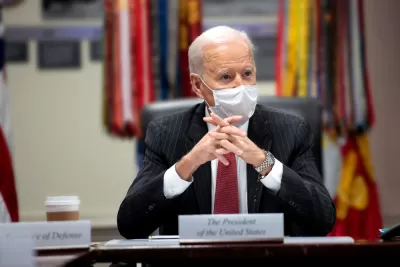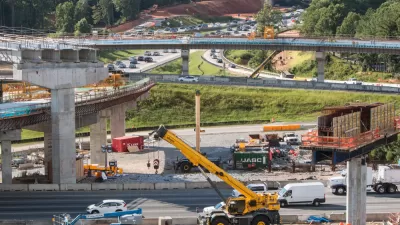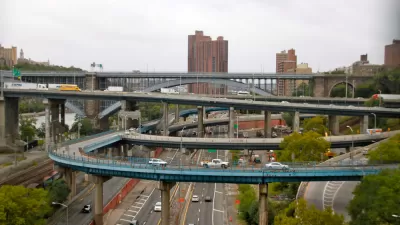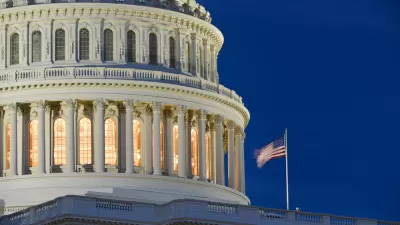There's plenty of room for analysis and discussion in a $1.2 trillion bill, so Planetizen's coverage of the historic bill continues.

The size and the scope of the Infrastructure Investment and Jobs Act (IIJA) is truly historic, so the bill will figure heavily in discussions about planning for years, and likely decades, to come. In the meantime, however, it's clear that a lot of media outlets are still working their way through the massive bill, and the coverage with specific geographic, industry, and environmental angles continue to pour over the newswires.
With this steady flow of news clogging up the tabs on my browser, I am offering one more (maybe; we'll see) compendium of new coverage of the IIJA. Planetizen published two previous articles attempting to make sense of the scale of the legislative effort, and what it means for the future of planning in a post-Covid world.
Key Details of the $1.2 Trillion Federal Infrastructure Bill – The broad strokes, niche interests, and geographic specificity of the IIJA. (Planetizen, November 15)
Historic 'Infrastructure Investment and Jobs Act' Passes Final Hurdle in Congress, Heads to Biden for Signature – Relevant history stretching back to the Great Recession and through the Trump administration provides context for the key facts about the IIJA known immediately after approval. (Planetizen, November 8)
One quick note before we get to the new coverage: It's clear that the Biden administration has decided to call the IIJA the "Bipartisan Infrastructure Bill." Despite the serious capitalization, this title is clearly a choice of political messaging—and is not the actual name of the bill, nor the name that will be used for the the bill at Planetizen moving forward. Other misconceptions about what's in and what's out of the final approved version as well as erroneous names for the IIJA are detailed in the previous articles above.
Specific Geographies
Infrastructure bill would send more than $10 billion to Michigan – The traditional home of the U.S. automobile industry will spend $7.3 billion of its $10 billion IIJA haul on roads. $1.3 billion of the remainder will fund water infrastructure (six years after a state of emergency was declared due to lead in the water pipes in Flint). (mlive, November 8)
Capping The Cross-Bronx: Infrastructure Bill To Be Used To Undo Robert Moses-Era Environmental Racism – Discussions about the potential for the IIJA will be leveraged to undo the legacy of racist planning and infrastructure programs so far seem to focus heavily on local examples in New York City, as exemplified by the controversy Transportation Secretary Pete Buttigieg stepped in immediately after the bill's approval. (Gothamist, November 10)
MTA officials eager for President Biden’s infrastructure bill to greenlight Second Ave. subway expansion – The long-promised extension for the Second Avenue Subway qualifies as a big ticket item, if New York can finally manage to get their act together with the help of funding from the IIJA. Gov. Kathy Hochul tweeted about that prospect after this article was published. (New York Daily News, November 14)
CA roads, bridges, and airports will get long-overdue fixes thanks to $45 billion from feds – The most populous state in the Union is expecting a huge payout, although maybe not in per capita terms, from the IIJA, much of which will be spent on deferred maintenance of traditional, carbon intensive modes of transportation. (KCRW, November 16)
The Westiest programs in Biden’s Infrastructure Investment and Jobs Act – Coverage of the IIJA's intentions for the U.S. West describes the bill as the "New Deal redux" and notes the bill's focus on ecosystem restoration. (HighCountryNews, November 16)
A Closer Look at Biden’s Historic Infrastructure Bill – Washington State is slated to receive $7 billion from the IIJA. One angle reported here that received relatively little attention in earlier coverage: the IIJA follows closely on the heels of United Nations 26th Climate Conference (COP26). (The Urbanist, November 17)
Infrastructure bill to bring $35 billion to Texas – Though no Texas Republican voted in favor of the IIJA, the state is set to received $35 billion in funding. This article lists roads, bridges, and public transit as the big ticket items for the Lone Star State. (Axios Dallas, November 17)
What the infrastructure bill means for water in Nevada and the West – "Nevada could receive about $405 million to fund water projects that focus on everything from fixing aging infrastructure to ensuring access to clean drinking water," reports Daniel Rothberg. (The Nevada Independent, November 18)
Specific Interests
Crash deaths are on the rise across the nation. The infrastructure bill opens the door to a safety overhaul. – The IIJA "includes dozens of safety provisions and adds billions to the money already sent to states to curtail traffic crashes and deaths," writes Michael Laris. The new funding is intended to counteract tragic trends in traffic safety during the pandemic, so it's worth noting that a lot of funding for traffic safety was cut from the bill earlier in negotiations. (The Washington Post, November 13)
Tribes hope infrastructure law means they'll finally get clean drinking water – Water supply inadequacies on the tribal lands of the Navajo Nation were connected to some of the most tragic outcomes of the early pandemic, so the word "hope" in the headline of this article is doing a lot of work. (NPR, November 15)
A $1.2 trillion opportunity to address America’s safety, equity, and climate crises – Corinne Kisner, executive director of NACTO, issued a statement after the IIJA's signing thi week, celebrating the wins for innovative transportation programs but also warning about the potential for the funding to reinforce the status quo of racial and environmental justice if left to the devices of states. (National Association of City Transportation Officials, November 15)
Racial Equity in Infrastructure, a U.S. Goal, Is Left to States – There are still very large unanswered questions about how states will divvy up the funds from the IIJA once it's out of the feds' hands. "It’s hard to have a national approach when the decisions are made state by state," says Beth Osborne, director of Transportation for America, as quoted in this article. (The New York Times, November 15)
Climate Actions in New Law Are Merely a Down Payment – A paywalled article digs into the energy efficiency, EV infrastructure, and mass transit funding included in the IIJA, with one caveat: "the potential of its climate investments hinges on the passage of the Build Back Better plan." (Bloomberg Green, November 16)
Highways become a culture war battlefield – The Cross Bronx Expressway makes another appearance as evidence in a larger discussion about highways as "both literally and metaphorically a structure of racism," as described by Rep. Ritchie Torres (D-NY). (Yahoo News, November 16)
Infrastructure bill unleashes funding to address risky dams - The IIJA will help repair thousands of aging dams, with $3 billion in funding available for capital investments. $585 million will go to the FEMA’s Rehabilitation of High Hazard Potential Dams Grant Program including $75 million for dam removal. (Associated Press via Federal News Network, November 16)
One surprising winner in Biden’s infrastructure bill: Biodiversity – While most climate advocates are expressing disappointment at the IIJA's intentions regarding carbon emissions, the bill does include an unprecedented amount of funding for adaptation measures intended to protect biodiversity—a "flip side of the climate change coin." (Grist, November 17)
In Colorado, President Biden’s infrastructure bill could help low-income residents ditch fossil fuels - The federal Weatherization Assistance Program will receive a $3.5 billion boost from the IIJA. "Energy assistance advocates estimate the increase will fund weatherization for an additional 400,000 homes in total," reports Sam Brasch. - (CPR News - November 17)
From safety to technology: Rail initiatives in infrastructure bill – Log-in is required to access this article that details the IIJA's funding for rail projects—varying from Amtrak to freight to grade crossings and more. (FreightWaves, November 17)
What Biden’s infrastructure bill means for wildfire management - Wildfire management is in the midst of an epoch-defining reform movement. The IIJA includes $3.3 billion for wildfire management, will raise wages for wildland firefighters and make some part-time positions permanent, and will allocate "$500 million each to thinning projects, planning and conducting prescribed fires, developing and improving fuel breaks where fires can be stopped or lulled, and mapping and defending at-risk communities." (HighCountryNews - November 19)

Trump Administration Could Effectively End Housing Voucher Program
Federal officials are eyeing major cuts to the Section 8 program that helps millions of low-income households pay rent.

Planetizen Federal Action Tracker
A weekly monitor of how Trump’s orders and actions are impacting planners and planning in America.

Ken Jennings Launches Transit Web Series
The Jeopardy champ wants you to ride public transit.

Washington Legislature Passes Rent Increase Cap
A bill that caps rent increases at 7 percent plus inflation is headed to the governor’s desk.

From Planning to Action: How LA County Is Rethinking Climate Resilience
Chief Sustainability Officer Rita Kampalath outlines the County’s shift from planning to implementation in its climate resilience efforts, emphasizing cross-departmental coordination, updated recovery strategies, and the need for flexible funding.

New Mexico Aging Department Commits to Helping Seniors Age ‘In Place’ and ‘Autonomously’ in New Draft Plan
As New Mexico’s population of seniors continues to grow, the state’s aging department is proposing expanded initiatives to help seniors maintain their autonomy while also supporting family caregivers.
Urban Design for Planners 1: Software Tools
This six-course series explores essential urban design concepts using open source software and equips planners with the tools they need to participate fully in the urban design process.
Planning for Universal Design
Learn the tools for implementing Universal Design in planning regulations.
Heyer Gruel & Associates PA
Ada County Highway District
Institute for Housing and Urban Development Studies (IHS)
City of Grandview
Harvard GSD Executive Education
Toledo-Lucas County Plan Commissions
Salt Lake City
NYU Wagner Graduate School of Public Service






























